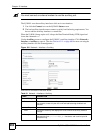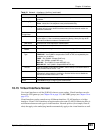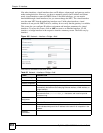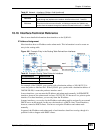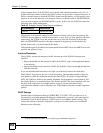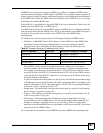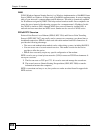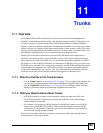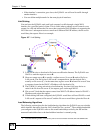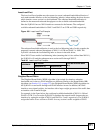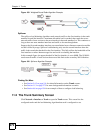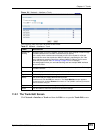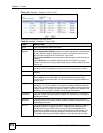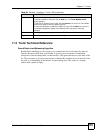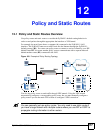
Chapter 11 Trunks
ZyWALL USG 100/200 Series User’s Guide
270
• If that interface’s connection goes down, the ZyWALL can still send its traffic through
another interface.
• You can define multiple trunks for the same physical interfaces.
Link Sticking
You can have the ZyWALL send each local computer’s traffic through a single WAN
interface for a specified period of time. This is useful when a redirect server forwards a user
request for a file and informs the file server that a particular WAN IP address is requesting the
file. If the user’s subsequent sessions came from a different WAN IP address, the file server
would deny the request. Here is an example.
Figure 187 Link Sticking
1 LAN user A tries to download a file from server B on the Internet. The ZyWALL uses
WAN1 to send the request to server B.
2 However remote server B is actually a redirect server. So server B sends a file list to
LAN user A. The file list lets LAN user A’s computer know that the desired file is
actually on file server (C). At the same time, register server B informs file server C that
a computer located at the WAN1’s IP address will download a file.
3 The ZyWALL is using active/active load balancing. So when LAN user A tries to
retrieve the file from file server C, the request goes out through WAN2.
4 File server C finds that the request comes from WAN2’s IP address instead of WAN1’s
IP address and rejects the request.
5 If link sticking had been configured, the ZyWALL would have still used WAN1 to send
LAN user A’s request to file server C and the file server would have given the file to A.
Load Balancing Algorithms
The following sections describe the load balancing algorithms the ZyWALL can use to decide
which interface the traffic (from the LAN) should use for a session
2
. The available bandwidth
you configure on the ZyWALL refers to the actual bandwidth provided by the ISP and the
measured bandwidth refers to the bandwidth an interface is currently using.
LAN
WAN1
WAN2
A
B
C
1
2
3
4
2. In the load balancing section, a session may refer to normal connection-oriented, UDP and SNMP2 traffic.



